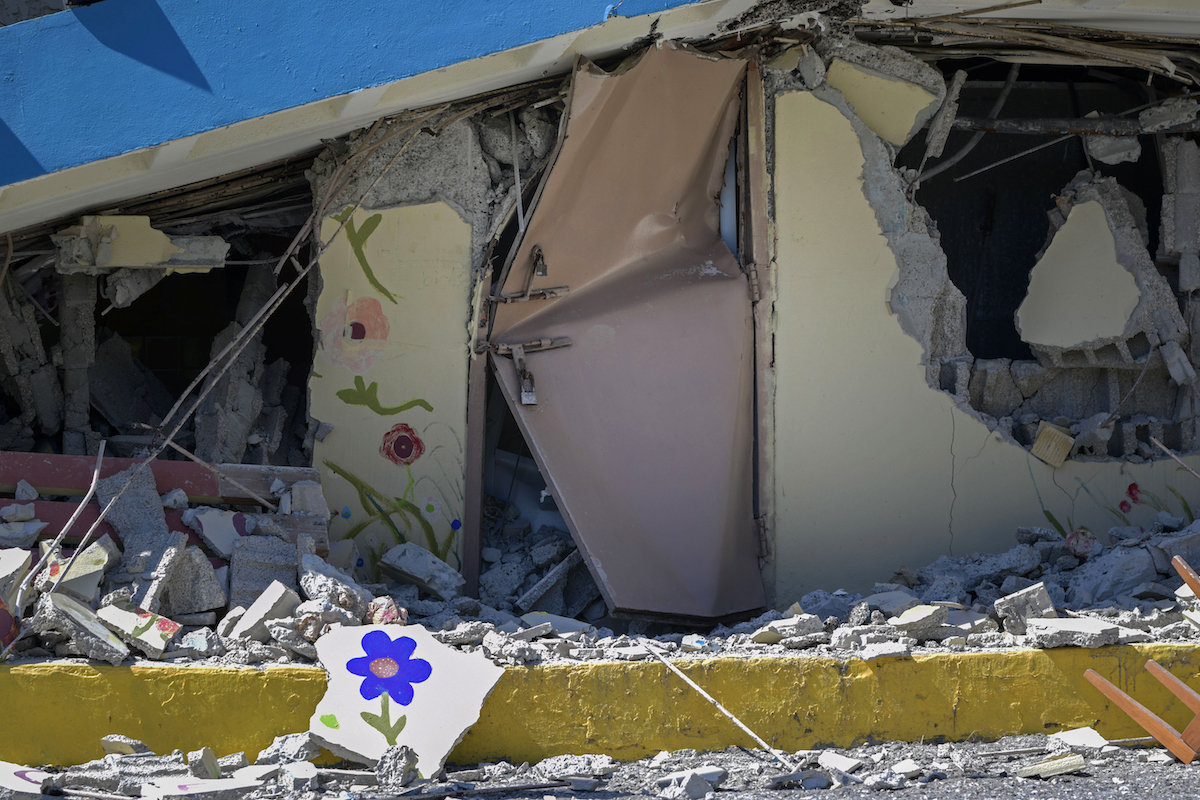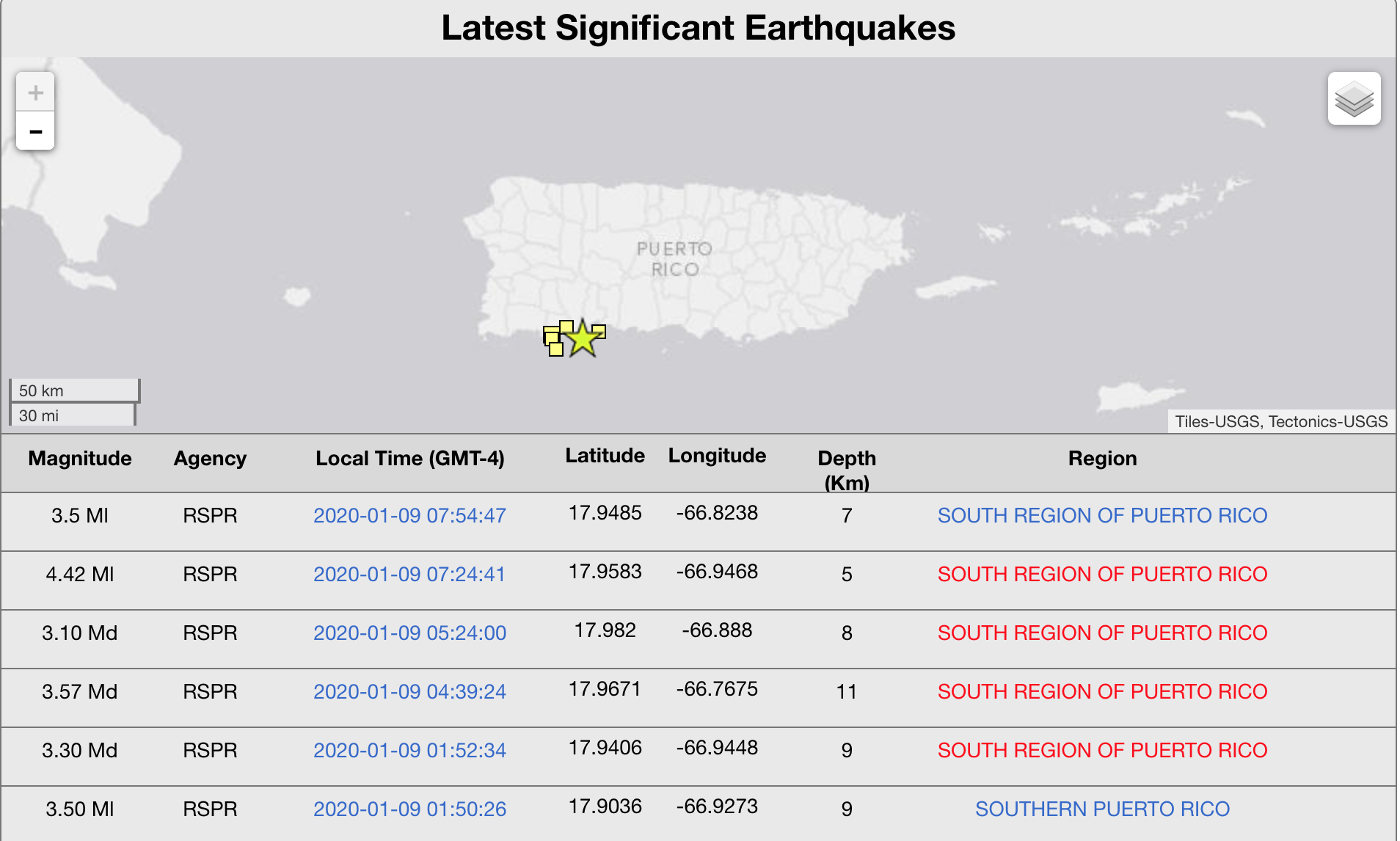

The Adripina Seda public school stands partially collapsed after an earthquake struck Guánica, Puerto Rico, Tuesday, January 7, 2020. (AP Photo/Carlos Giusti)
SAN JUAN, Puerto Rico — After a 6.4 magnitude earthquake rattled Puerto Ricans before dawn on Tuesday, the island found itself in total darkness. The massive quake and its hundreds of aftershocks took down the electrical grid with it, leaving millions without power, one dead, and dozens of homes and businesses in the southern coast in shambles.
The 6.4 quake is the most powerful occur since seismic activity began to shake the island on December 28.
When the dust settled and the sun finally rose, Puerto Ricans in the south found extensive damage to homes, schools, churches, and historical landmarks. This was followed by what many on social media called the longest day ever, which included several strong aftershocks, choppy cell service, and emotional distress for many.
Así luce por dentro la Iglesia de la Inmaculada Concepción, Guayanilla. El Santísimo fue rescatado. pic.twitter.com/UAMTbBf7x2
— Walter Soto León (@waltersotoleon) January 7, 2020
Governor Wanda Vázquez Garced declared a state of emergency on Tuesday, and that same night, president Donald Trump signed it into effect. It is important to note that the initial declaration only covers immediate needs and not full damage assessment, which will be expected later, although it is not clear when or what will actually happen. There are calls by local leaders whose municipalities were impacted to have the federal government declare a federal disaster zone.
Local officials of #PuertoRico's three southern municipalities are asking @realDonaldTrump and federal gov't to declare these three municipalities as federal disaster zones. The current declaration from @WhiteHouse does not cover that. #PuertoRicoEarthquake
— Julio Ricardo Varela (@julito77) January 9, 2020
Similar to when Hurricane María hit in 2017, it’s been the united communities that have helped those struck harder by the earthquakes get through. But in times of an unprecedented and unpredictable crisis like this, people are also scared, moody, and paranoid.
Many historical sites have been destroyed die to this mornings series of earthquakes. Las Ruinas de Barinas, Yauco being one of them?#PuertoRicoEarthquake #PuertoRico #TemblorPR #Temblor pic.twitter.com/HJK9qswFlt
— josejay™ ? (@josejay_413) January 7, 2020
Twitter, Facebook, and WhatsApp are being used as primary sources of important information, memes, and real-time reactions to the ongoing seismic event.
Social Media and Misinformation
When it comes to disaster situations such as hurricanes or earthquakes, people tend to rely on the use of social media to get quick information.
Before María struck, Puerto Ricans relied on the Facebook Live videos that local meteorologist Ada Monzón would publish daily to get accurate information on the trajectory of the hurricane. But at the same time, rumors like the “first ever Category 6 Hurricane” or conspiracy theories began to make social media rounds, especially through WhatsApp.
Similarly, during the Summer of 2019 protests, rumors about former governor Ricardo Rosselló’s resignation —weeks before it actually happened— were circulating through the same sites.
And since the beginning of the continuous seismic activity that began during the last days of 2019, so did inaccurate facts about what to do during a crisis, false “8.0 magnitude” earthquake predictions, and fracking in the southern coast conspiracy theories.
It’s important to note that the most reliable sources of information during emergencies are government agencies and experts on the topic.
Organizations like the Red Sísmica de Puerto Rico and Central Meteorológica y Geológica del Caribe, and experts like José Molinelli and Víctor Huérfano post quick and accurate information on earthquakes and meteorological events.
It’s important you trust experts and not what the friend of a friend forwarded through WhatsApp.
Metrocentrism
Although the major earthquake rocked the entire island, most of the damage has been concentrated on the south and southwest regions of the island, near the epicenter. People in the southern municipalities have been sleeping in their cars, makeshift tents, and shelters, due to collapsed homes, or fear of their homes collapsing. The main areas impacted are Guánica, Guayanilla, Yauco, Peñuelas and the city of Ponce.
Yauco has 1,200 people in shelters plus 1,600 people outside of their homes. That's almost 3,000 people outside of their homes. This is what the mayor shared this morning. #PuertoRicoEarthquake
— Julio Ricardo Varela (@julito77) January 9, 2020
There have also been multiple reports of bad cell service, and water and electric power aren’t expected to come back for a while. A Thursday morning CBS News report showed the damage to Costa Sur, one of the island’s most important power plants.
Here's our report for @cbsthismorning showing earthquake damage inside Costa Sur power plant in southern Puerto Rico. The operations manager of the plant predicts he can get the plant up and running in a month. The CEO of Puerto Rico's Electric Power Authority says it'll be 1yr. pic.twitter.com/Y581BObmv1
— David Begnaud (@DavidBegnaud) January 9, 2020
Meanwhile, parts of the Metropolitan Area in San Juan, Carolina, and Guaynabo have already had power and water service restored, meaning some people are beginning to see the island as business as usual.
It’s clear that the earthquakes didn’t hit everybody equally, and it’s the poorer communities who have no choice but to build houses that aren’t up to regulation that have lost everything. Instead of using social media to rub salt on the wound and flaunt non-existent engineering and construction experience, donate to local organizations or help rebuild homes.
Additional images of the M6.4 earthquake destruction this morning in the town of Guayanilla, Puerto Rico USA pic.twitter.com/1BSVswTD9V
— J.A. Rodriguez Jr. (@JARodriguezJr) January 7, 2020
Meanwhile, it is expected that aftershocks and more seismic activity will continue, heightening concerns about conditions getting worse. In fact, there were at least six aftershocks recorded on Thursday morning.


The government is urging people to be prepared. For the latest more updates, you should follow these profiles: @redsismica, @adamonzon, @RobbyCortes, @radioislatv, @fortalezapr, @LaPerlaPR, and @danicacoto.
***
Natalia Rodríguez Medina is a journalist based in Puerto Rico. She tweets from @nataliarodmed.



He says the best source of information is the government. Are you kidding? The government?
The government is only one of several sources here.
So, the fracking and drilling has nothing to do with weakening anything that would make quakes along the northern plate possible or more likely?
The island has been subject to the whims of industrialists and colonialists for far too long, is it possible that they are contributing to the problems (post Maria) while contributing to new ones (earthquakes). I’m just trying to get a good understanding from local sources